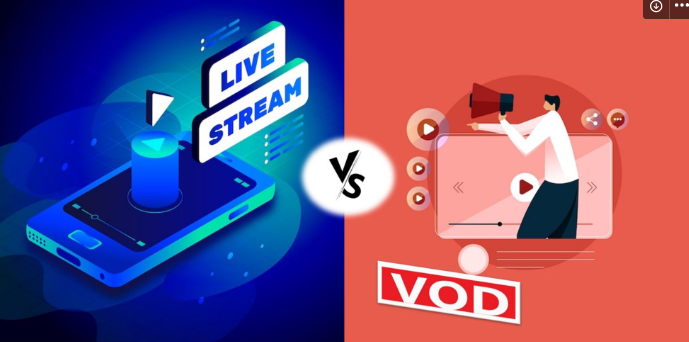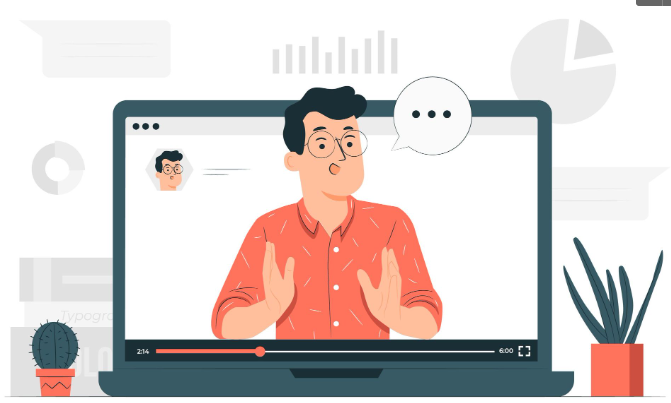Dive into the transformative world of digital media, where Video On Demand (VOD) and Live Streaming are changing how we consume content. In this exploration of Video On Demand vs Live Streaming, we’ll guide you in choosing your optimal digital media path. Let’s embark on this insightful journey together.

Which Digital Video Format Is Right for You? On-Demand or Live Streaming
The Evolution of Media Consumption
Traditional Television
For decades, traditional television was the cornerstone of media consumption. Introduced in the mid-20th century, it gradually evolved from black and white to color, and now to high definition and beyond. Television sets were the focal point of households, with families gathering around to catch the latest news, watch sports games, or enjoy their favorite shows. These experiences were bound by a broadcast schedule, turning television viewing into a timely communal activity.
Rise of Online Content: VOD and Live Streaming
As we moved into the 21st century, a significant shift in media consumption began to take place. The advent of the internet, along with groundbreaking technological advancements, paved the way for new forms of entertainment – Video on Demand (VOD) and live streaming. These digital platforms have transformed the media landscape, challenging traditional norms and offering an evolved, more personalized viewing experience.
Understanding Video on Demand
What is Video on Demand and How It Works
Video on Demand (VOD) is a system that allows users to select and watch video content at their convenience. Unlike traditional television, it is not bound by broadcast schedules. Instead, users can access an extensive library of content, including films, TV shows, documentaries, and more, anytime and anywhere. This is made possible through streaming platforms that host this content online, such as Netflix or Disney+.

Explaining VOD and Its Functionality
The Benefits of VOD
There are several key advantages that contribute to the popularity of VOD:
1. User Control: VOD places the power in the hands of the viewers. You decide what you want to watch, when, and even where, thanks to mobile streaming. Want to pause your favorite show for a snack break? No problem. With VOD, the control is literally at your fingertips.
2. Content Availability: The vast array of content available on VOD platforms is truly staggering. From popular TV shows and movies to indie films and documentaries, catering to all tastes. You no longer need to wait for a network to air your preferred content – it’s readily available to you on demand.
3. Personalization: VOD platforms typically offer personalized recommendations based on your viewing history. This adds another layer of convenience, as you can discover new shows or movies tailored to your tastes.
The Limitations of VOD
Despite the many benefits, VOD does come with its own set of limitations:
1. Lack of Real-Time Engagement: A major downside of VOD is its inability to offer real-time engagement and shared experiences that traditional TV or live streaming provides, where viewers watch and react simultaneously.
2. Potential Content Saturation: The sheer volume of content available on VOD platforms can be overwhelming for some users. With so many options, it can be challenging to sift through and decide what to watch – leading to a paradox of choice.
Understanding Live Streaming
What is Live Streaming and How It Works
Now, let’s shift our focus to another significant player in the media landscape – live streaming. In essence, live streaming involves broadcasting events or content in real-time over the internet. It’s like live TV, but instead of being broadcast over traditional networks, it’s delivered over the web. Platforms like YouTube Live and Twitch have popularized this format, providing content ranging from gaming, concerts, sports events, to even real-time vlogging.

How does live streaming work, and what is it?
The Benefits of Live Streaming
Live streaming carries a host of unique benefits that set it apart:
1. Real-Time Interaction: The prime allure of live streaming is its real-time interaction. Viewers can comment, ask questions, or react to the content and creators on the spot, fostering a unique sense of community uncommon in other media forms.
2. Event Coverage: Live streaming allows for instantaneous coverage of events, making it a popular choice for broadcasting sports games, concerts, conferences, and more. It enables viewers to be part of an event from anywhere in the world, breaking down geographical barriers.
3. Unique Content Experience: Each live stream is unique. The spontaneity and unpredictability associated with broadcasting in real-time provide a fresh and exciting viewing experience. This uniqueness, coupled with the ability to interact, adds a level of excitement and immediacy that pre-recorded content cannot match.
The Limitations of Live Streaming
While live streaming offers a distinctive content experience, it does come with its own set of challenges:
1. Technical Difficulties: Live streaming relies heavily on technology and a stable internet connection. If either fails, it can lead to interruptions, low-quality streams, or even the cancellation of the stream. These technical difficulties can mar the viewing experience and are often beyond the control of the viewer or the content creator.
2. Limited Replay Capabilities: Unlike VOD, some live streams do not offer the option to replay the content. If you miss the stream, you might miss out entirely, depending on the platform and the streamer’s settings.
What about VOD vs OTT vs CTV?
Over-The-Top (OTT) platforms deliver film and TV content over the internet, bypassing traditional cable or satellite services. Video-On-Demand (VOD) allows users to select and watch video content when they choose, rather than at a scheduled broadcast time. Connected TV (CTV) refers to any TV that can be connected to the internet and access content beyond traditional broadcasts, including OTT and VOD services.
While this may sound a bit confusing, the foremost thing to remember when comparing CTV vs OTT programming is that OTT material is seen through CTV, so does VOD.
Comparing Video on Demand vs Live Streaming
To better understand the differences between Video on Demand vs live streaming, let’s look at a comparison table detailing their pros and cons:
| Video on Demand (VOD) | Live Streaming | |
|---|---|---|
| Pros | ||
| User Control | High (watch anytime, anywhere) | Limited (bound by streaming schedule) |
| Content Availability | Extensive | Depends on events/schedule |
| Personalization | Yes (tailored recommendations) | Limited |
| Real-Time Interaction | No | Yes |
| Unique Content Experience | Depends on content | High (due to real-time nature) |
| Cons | ||
| Real-Time Engagement | Limited | High |
| Potential Content Saturation | Yes | Less likely |
| Technical Difficulties | Less likely | More likely |
| Limited Replay Capabilities | No | Often, depends on platform |
Choosing between VOD and live streaming ultimately depends on what you value most as a viewer. If you prefer control, the ability to watch at your own pace, and a vast array of content, then VOD might be your best choice. On the other hand, if real-time interaction, the excitement of live events, and unique content experiences appeal to you, then live streaming would be the way to go.

Choosing between VOD and live streaming
In the dynamic media world, VOD and live streaming cater to varied preferences. Understanding each platform’s offerings and aligning them with your habits is crucial.
Case Studies: Video on Demand vs Live Streaming in Action
The Success of VOD: Netflix and Disney+
When discussing Video on Demand, the success of platforms like Netflix and Disney+ cannot be overlooked. Netflix revolutionized the industry with its extensive content and personalized suggestions, dominating the VOD market through the convenience of binge-watching.
Disney+, on the other hand, leveraged its vast archive of beloved classics along with new, exclusive content to quickly rise in the VOD space. It’s the mix of nostalgia and novelty that has driven Disney+’s success in the world of Video on Demand vs live streaming.
The Success of Live Streaming: Twitch and YouTube Live
On the live streaming front, Twitch and YouTube Live stand as successful examples. Twitch, primarily known for gaming, has created a community-driven platform where viewers not only watch their favorite gamers in real-time but also engage in live chats, making each stream a unique experience.
Through interactive live streams featuring diverse content from music concerts to tutorial sessions, YouTube Live has gained an edge in the live streaming field, influencing the Video on Demand vs live streaming discourse.
These case studies highlight the varied strengths of both VOD and live streaming, reflecting their respective successes in the evolving landscape of media consumption.

The success of Video On Demand vs Live Streaming
Conclusion
In the grand scheme of Video On Demand vs Live Streaming, choosing the right platform ultimately boils down to your personal preferences. Both have reshaped content consumption with unique strengths and limitations. As we continue to navigate this exciting digital landscape, remember the choice is yours to make, shaping your own unique path in the world of digital media consumption.










